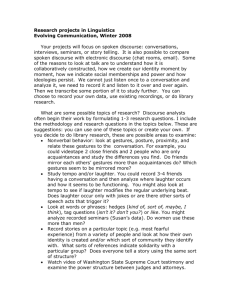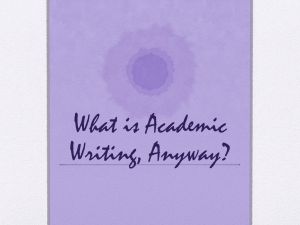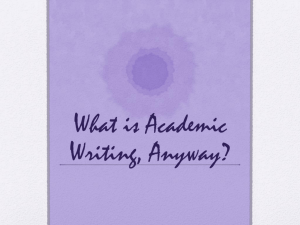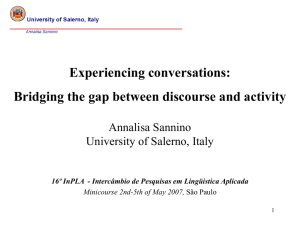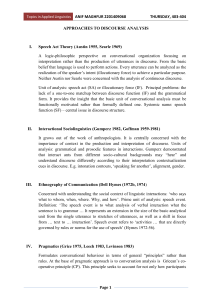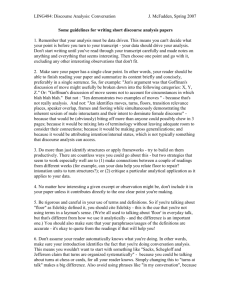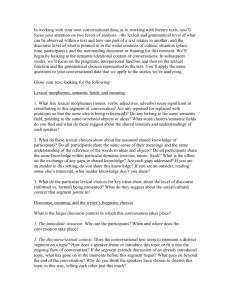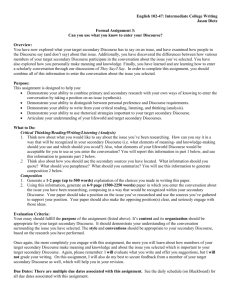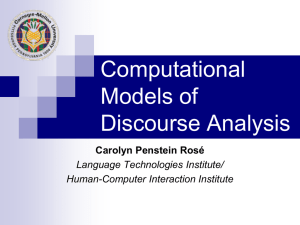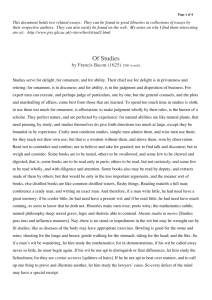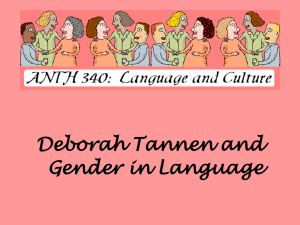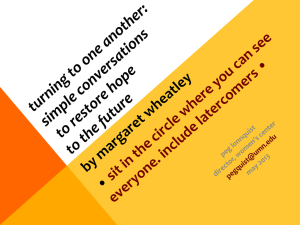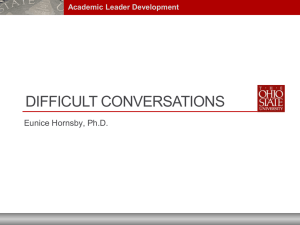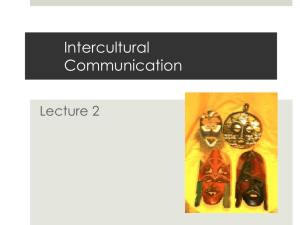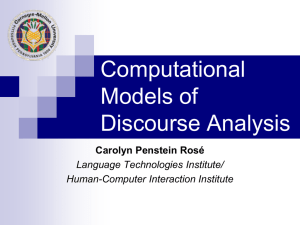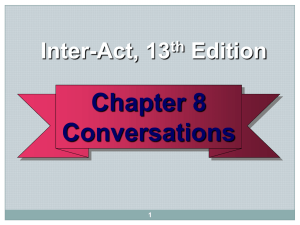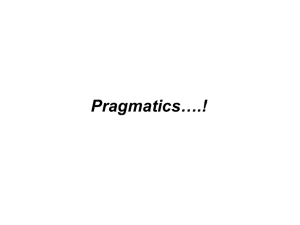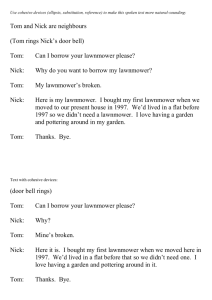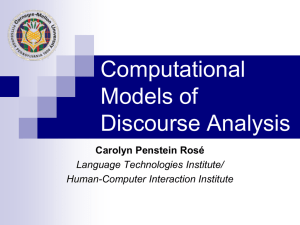Session PowerPoint
advertisement
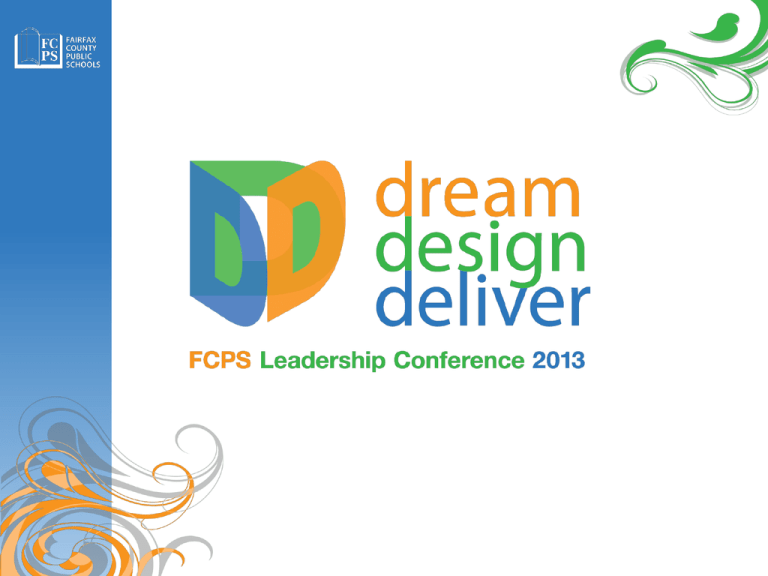
All Great Ideas Begin by Talking Out Loud: Redesigning Classroom Conversations Outcomes for this Session • Understand the importance of academic conversation • Experience strategies that promote academic conversation • Reflect on next steps for increasing academic conversation in your school Conversation Cube • Work with one to two others and toss the cube. • Read the quote on top of the cube • Reflect on quote & discuss: How does this relate to teaching and learning in your school? What is Academic Language? Phonology Vocabulary Grammar Sociolinguistics Discourse • Academic & Technical • Sentence Frames • Cooperative Learning Structures • Language of Product - Genre Metacognition Learner Identity • Builds self-efficacy by valuing experience, learning styles, and language Language • Identify language and academic discourse of the content area Learning Community • Promote student to student communication in the classroom through cooperative learning structures Schema Building • Facilitate knowledge construction around conceptual understanding by building on background knowledge and making connections Students listen and may answer 1 question at a time Unsupported opportunities: group discussions, pairshares Scaffolded oral output: sentence frames, cooperative learning structures Extended academic discourse: quantity, quality, meaning creating ACADEMIC Discourse “Academic discourse not only describes knowledge, it sustains the creation of it.” Integrating Critical and Creative Thinking Strategies It is not about whose viewpoint is “right” . . . it is getting to deeper understandings with new and broader perspectives Three types of argument: 1. Social Arguments 2. Literacy Argument 3. Nonfiction Topic Social Arguments • Should chocolate milk be allowed in schools? https://www.youtube.com/watch?v=mjxpeAom5HU https://www.youtube.com/watch?v=eQ4wGDl56Zg • Should soda be sold in school vending machines? Literary Arguments • Giving Tree – is tree weak or strong? • Children learn to be more nuanced • Lead to deeper understandings of abstract ideas • Example: Socratic Seminar, http://www.ebmcdn.net/fcps/fcps_video_vie wer.php?viewnode=194301d2a52ff In Robert Frost’s poem, “The Road Not Taken” is the poet ambivalent, self-assured, regretful, or adventuresome? How does this poem connect to the focus on increasing academic conversations school? Thein your Road Not Taken by Robert Frost Two roads diverged in a yellow wood, And sorry I could not travel both And be one traveler, long I stood And looked down one as far as I could To where it bent in the undergrowth Then took the other, as just as fair, And having perhaps the better claim, Because it was grassy and wanted wear; Though as for that, the passing there Had worn them really about the same, And both that morning equally lay In leaves no step had trodden black. Oh, I kept the first for another day! Yet knowing how way leads on to way, I doubted if I should ever come back. I shall be telling this with a sigh Somewhere ages and ages hence: Two roads diverged in a wood, and I – I took the one less traveled by, And that has made all the difference. Nonfiction Argument • What they know comes from the text • Requires student to sort, weigh, and evaluate evidence • Reasoning coupled with evidence • Examples: Structured Academic Controversy, Debate Academic Controversy Have you learned the lessons only of those who admired you, and were tender with you, and stood aside for you? Have you not learned great lessons from those who braced themselves against you, and disputed passage with you? Walt Whitman, 1860 Scaffolding Academic Controversy It was the __________’s opinion that barbed wire led to _______. While ________ felt that barbed wire was _________, ________ felt that it ___________.. According to ______ barbed wire is _______ because____________. Academic Controversy exists when one student’s idea, information, conclusions, theories, and opinions are incompatible with those of another, and the two seek to reach an agreement. (Johnson & Johnson, 1995) Aristotle called this deliberate discourse the discussion of advantages and disadvantages of proposed actions aimed at synthesizing novel solutions. Student Talk vs. Teacher Talk ACADEMIC CONVERSATIONS TRADITIONAL CLASS DISCUSSIONS 97% student talk 97% teacher talk Average student response – 8-12 seconds Average student response – 2-3 seconds No teacher approval or disapproval Thinking is paramount, backed up with textual evidence Students listen primarily to peers Teacher judgment; emphasis on correctness Rightness is paramount; thinking ends when someone is right Students listen primarily to teacher Student ownership for “flow” Teacher ownership for “flow” What is happening in the brain? • Reading words or looking at a picture (Visual cortex) • Understanding words (Wernicke’s area) • Putting thoughts into words (Broca’s Area) • Explaining thinking to a partner (Widespread activity) Journey to Student Driven Academic Conversation 4 Leadership 3 Listening Learn how to share 2 leadership Cooperation with the Work together to 1 listen to each other teacher. Participation Learn how and the text. to lead the Become aware Examine their group. of problems like assumptions and perspectives and factions and Learn to speak to how they differ from dominance. each other with Work together those of the text and minimal mediation by one another. to enable all facilitator. Begin to change members to Learn discussion their opinions speak. skills because of what Invest in process others say. through sharing Stand Up, Hand Up, Pair Up 1) What is the purpose of using academic conversations? 2) Describe how you could support moving from talk to discourse in your building. Conversation starters: I would ____ in order to ______. If ___, I would use _____. Conversation prompts: Can you elaborate on that? Please give an example. I was wondering what you meant by… To build on what you said… Academic Conversation Skills Placemat x © Jeff Zwiers To succeed in life, students should be able to write and speak with clarity, and to read and listen with comprehension. Language and thought are inextricably connected, and as students develop their linguistic skills, they hone the quality of their thinking and become intellectually and socially empowered. - Ernest Boyer, Carnegie Foundation How might I apply this information in my school? What resources and support might I need? What professional Who at my school development might can help lead the my teachers need? way?
